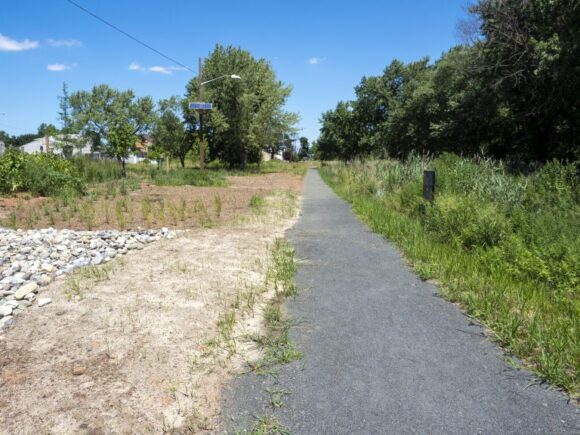
Looking north along a former block of Watson Ave in Woodbridge, NJ. Formerly a quiet residential street with houses, frequent flooding has resulted in this segment of roadway being repurposed into open space with a walking path through the Blue Acres program. Photo: Matt Drews.
By Carol Peters, EOAS Communications
A wildlife and conservation management expert for Rutgers Cooperative Extension, EOAS faculty member and Associate Professor Brooke Maslo works with local NJ municipalities to help them manage and restore properties in FEMA-established flood-prone areas purchased through the DEP Blue Acres program.
Imagine the plight of families in New Jersey who own homes in the state’s extensive flood plains. When storms hit, which they do more frequently in 2022 due to climate change, their houses flood and are often severely damaged. During these flooding events, the residents are often in danger. Many can’t afford to raise their houses on stilts, purchase insurance policies to offset the cost of repairs, or sell their homes at a loss. How can they escape?
The New Jersey Department of Environmental Protection’s Blue Acres program offers these homeowners a solution. Blue Acres, which was launched by the state in 1995, purchases homes in FEMA-established flood prone areas or within 100-year flood plains, and then demolishes them, leaving open space. Blue Acres thus simultaneously assists residents in peril and helps the state meet its goal to increase its percentage of permanently protected green space.
But once these houses are gone, and the lots are vacant, what happens to these properties? The state buys and destroys the houses, but they don’t manage these land parcels afterwards. They become deed restricted properties that need to be managed by the towns where they reside.
Some of the municipalities tasked with managing Blue Acres properties have sought assistance from EOAS faculty member Brooke Maslo. Maslo is an Associate Professor in the Department of Ecology, Evolution, and Natural Resources, at the School of Environmental and Biological Sciences, Rutgers University-New Brunswick, and as well as an Extension Specialist in Wildlife Ecology in the Wildlife Conservation and Management Program in the Rutgers New Jersey Agricultural Experiment Station. She has a Ph.D. in Ecology and Evolution, and a professional background in biological resources engineering and ecological restoration. Her research focuses on conservation biology, wildlife ecology, and habitat restoration.
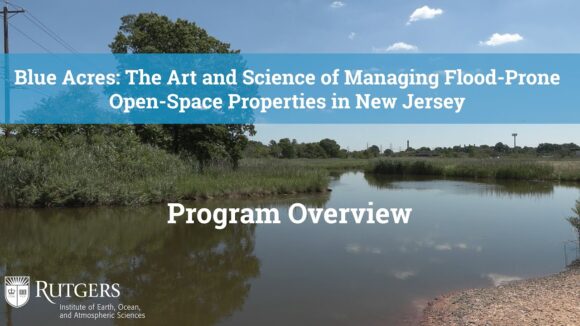 As an extension specialist, Maslo said, “part of my role is to create and find solutions to the most pressing environmental issues affecting the stakeholders of New Jersey.”
As an extension specialist, Maslo said, “part of my role is to create and find solutions to the most pressing environmental issues affecting the stakeholders of New Jersey.”
Blue Acres is funded by FEMA, Maslo explained, so “after Superstorm Sandy in 2012 there was a sizeable influx of money funneled into Blue Acres from FEMA because the damage was acute, severe, and fresh in everyone’s mind. Eventually though, after a few years of focusing on ocean-front coastal areas, Blue Acres didn’t achieve much success because many of those communities contain high-end properties (often 2nd homes). Property owners in that category could afford to wait for the insurance money to come in, or they could rebuild and ‘build back better’ as one of the slogans was. So Blue Acres began to turn its attention to the more inland flood plains within coastal and non-coastal communities.”
Maslo works with other Rutgers, federal, state, and municipal partners, such as landscape architects, to create master plans to help the towns manage the parcels once they are cleared, with an aim to restoring the properties ecologically as well as creating spaces for recreation and enjoyment. Maslo and her team study ways to improve public amenities, habitats, and the floodwater plains.
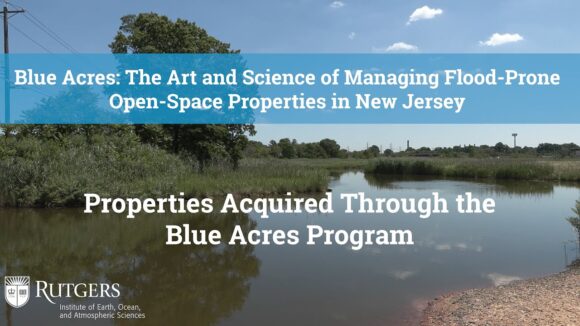 “Many people assume the purchase of the properties by Blue Acres is the endgame to a climate resilience strategy. To me, it’s only the beginning. I’m trying to change the narrative of buyouts from ‘coastal retreat’ to ‘landscape adaptation…’ to transform these previously developed landscapes into biodiverse, ecologically functioning public amenities,” Maslo said.
“Many people assume the purchase of the properties by Blue Acres is the endgame to a climate resilience strategy. To me, it’s only the beginning. I’m trying to change the narrative of buyouts from ‘coastal retreat’ to ‘landscape adaptation…’ to transform these previously developed landscapes into biodiverse, ecologically functioning public amenities,” Maslo said.
By managing these parcels, Maslo is helping NJ municipalities and the state to more effectively manage natural disasters and then steward community resiliency afterward. “It’s not enough to just be aware of the possibility of increasing disasters because of climate change, because we can’t sustainably practice disaster avoidance everywhere. The storms are going to arrive when they arrive. We can’t prevent or avoid them. But what we can do is re-establish the functions of natural systems and use them to increase resilience. As Americans, we don’t like to run away from anything – we don’t like to retreat – we like to stand up and fight. But when it comes to adjusting to climate change, retreat does not mean giving up. It just means we need to adapt. Being proactive is critical and that’s what we are aiming to do,” Maslo said.
Woodbridge, Pompton Lakes, and Sayreville are three communities with Blue Acres properties to manage who have sought Maslo’s assistance, and recently she has been focusing her work in Woodbridge, where Blue Acres has purchased over 200 properties in the town so far and the town is very committed to managing and restoring these land parcels.
A significant portion of Woodbridge Township is at significant risk of flooding, Maslo said, because it is bisected by the Woodbridge River, and bounded on two sides by the Heards Brook and the Arthur Kill.
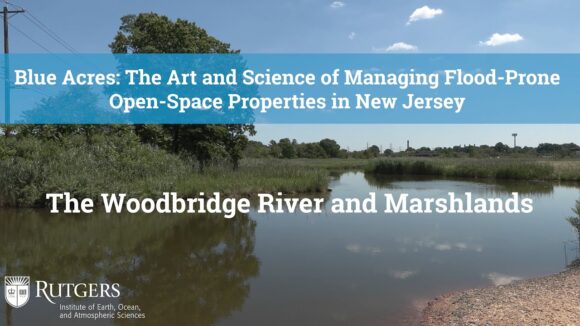 In Woodbridge, Maslo and her team are currently focused on five neighborhoods where Blue Acres bought out properties in flood prone areas. One of them is the Watson-Crampton neighborhood which sits along the Woodbridge River.
In Woodbridge, Maslo and her team are currently focused on five neighborhoods where Blue Acres bought out properties in flood prone areas. One of them is the Watson-Crampton neighborhood which sits along the Woodbridge River.
Maslo began this Woodbridge project by examining the land left from contiguous buyouts, and she soon realized she could create a public walking and biking trail starting from the headwaters and running all the way down to the heart of Woodbridge, ending at the train station.
So far, Maslo and her team have built the trail and in the process have restored 11 acres of forest and 5 acres of meadow in Woodbridge. They oversaw the trail design and designed, wrote, and posted accompanying interpretive signs. They have also removed invasive species and planted native species along the trail.
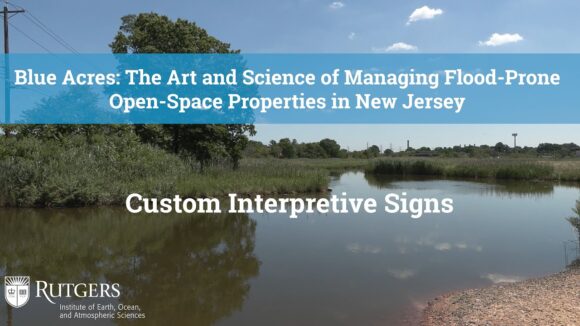 This particular project worked well, Maslo said, because the properties were purchased contiguously. But Maslo also works in Woodbridge neighborhoods where Blue Acres properties are nestled within still lived-in properties. Maslo calls these areas “checkerboards,” and said managing these properties requires a different approach. Maslo calls possible solutions for these individual land parcels “pocket parks.” For example, she said, in these spots they might install a playground if there isn’t already one close by, or a pollination garden, a rain garden, or a shady place to read.
This particular project worked well, Maslo said, because the properties were purchased contiguously. But Maslo also works in Woodbridge neighborhoods where Blue Acres properties are nestled within still lived-in properties. Maslo calls these areas “checkerboards,” and said managing these properties requires a different approach. Maslo calls possible solutions for these individual land parcels “pocket parks.” For example, she said, in these spots they might install a playground if there isn’t already one close by, or a pollination garden, a rain garden, or a shady place to read.
“Letting these properties just sit and ‘return to nature’ is not a solution, Maslo said. “This is a common misconception. Previously human-dominated, built-on landscapes can never be ‘pristine’ again. The soil needs to be cleaned up. There may be remaining asphalt from the driveways needing to be removed. We also need to manage invasive species growing on the properties, removing these and replacing them with native species to restore the habitat.
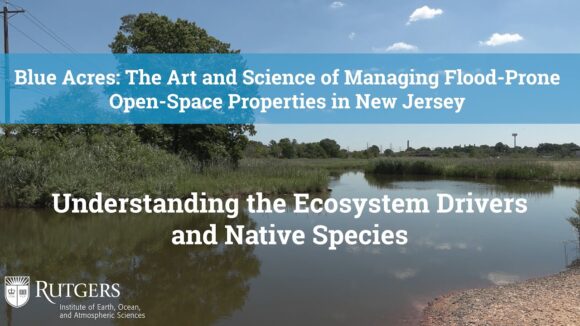 Working with local residents to learn how they would like to restore these parcels is a priority for her, Maslo said. “We hope the public will express their opinions about how they’d like see these properties transformed into public use spaces,” Maslo said. “We are learning what works for each town. Restoring these parcels can be an emotional issue for many residents. When people sell their houses to Blue Acres, many feel a sense of abandonment. It’s not just about the money. They leave behind many memories in these houses that have not only been sold but also demolished.”
Working with local residents to learn how they would like to restore these parcels is a priority for her, Maslo said. “We hope the public will express their opinions about how they’d like see these properties transformed into public use spaces,” Maslo said. “We are learning what works for each town. Restoring these parcels can be an emotional issue for many residents. When people sell their houses to Blue Acres, many feel a sense of abandonment. It’s not just about the money. They leave behind many memories in these houses that have not only been sold but also demolished.”
Beyond working physically in local towns to help restore properties, Maslo is also creating a primer/handbook/guide to advise flood resistant communities on how to restore Blue Acres properties. Maslo said the primer is a document that pulls together information that is already available but has never been easily accessible or all in one place. The aim of the primer, Maslo said, is to empower communities to know they can do restoration work to help their towns become more resilient in the face of natural disasters.
However, Maslo cautioned, town residents will need to be patient to see the results of her master plans come to fruition. “When a new condominium complex is built, the last step the builders take before listing them for sale is to install landscaping around the property. I call this ‘insta-habitat.’ We are not doing that type of work with Blue Acres land. Ecological restoration takes time.”
For example, she said, they plant young, small native trees because they cost less. But they need to be protected from deer and geese to be able to grow and mature and this process can take years.
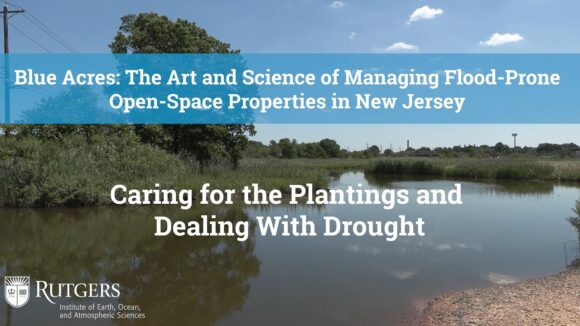 “I love the conservation and wildlife management research I conduct in my Rutgers lab, but applying my findings to real-world, local problems is the most rewarding aspect of my work,” Maslo said. “It is really meaningful to me and my team to stand on the new trail we’ve built in Woodbridge, read the interpretive signs we’ve designed to educate residents and visitors about the trail, and to know that people are using the trail, learning from it, and enjoying it.”
“I love the conservation and wildlife management research I conduct in my Rutgers lab, but applying my findings to real-world, local problems is the most rewarding aspect of my work,” Maslo said. “It is really meaningful to me and my team to stand on the new trail we’ve built in Woodbridge, read the interpretive signs we’ve designed to educate residents and visitors about the trail, and to know that people are using the trail, learning from it, and enjoying it.”
Maslo’s research is supported by the New Jersey Department of Environmental Protection (NJDEP) Blue Acres Program and the U.S. Fish and Wildlife Service (USFWS).
In August 2022 Maslo received an additional $400,000 from the National Fish and Wildlife Coastal Resilience Fund. Maslo will use the funds to complete the final design and permitting of their preliminary work increasing flood resilience of the Woodbridge River floodplain and its surrounding neighborhoods.

